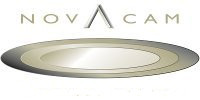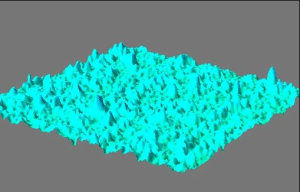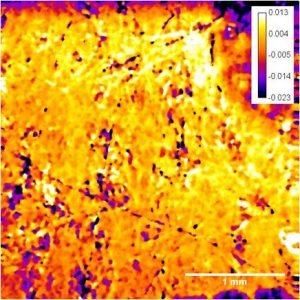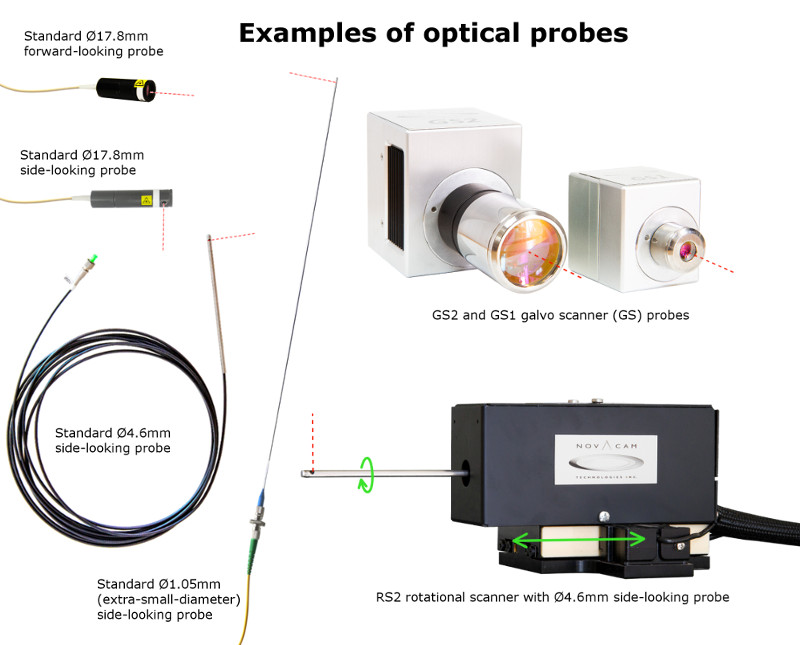Roughness
High-precision non-contact roughness measurements
NOVACAMTM 3D metrology systems deliver fast and reliable non-contact 3D measurements of surface roughness parameters. They offer:
- Precision better than 1 µm
- Ability to use the same system to measure 2D roughness (Ra, Rq, Rsk, Rku, Rv, etc.), 3D roughness, 3D geometry (GD&T parameters), flatness, waviness, and/or defects – depending on its configuration
- High-speed scanning: acquisition of 2,100 to 100,000 of 3D points per second
- Real-time feedback on manufacturing or coating processes: application data is typically forwarded to process control software
- Easy visual inspection: 3D surface maps, height and intensity images, depth profiles, etc.
Sample roughness measurement parameters of a fuel cell plate (height image on the right) are presented here below.
| Roughness values for fuel cell plate | Value | |
|---|---|---|
| Ra | Average roughness | 0.01 mm |
| Rq | Root mean square roughness | 0.01 mm |
| Rsk | Skewness | -0.05 mm |
| Rku | Kurtosis | 13.03 |
| Rv | Maximum profile valley depth | -0.06 mm |
| Rp | Maximum profile peak height | 0.09 mm |
| Rt | Maximum height (distance from highest peak to lowest valley) | 0.16 mm |
Surfaces can be reflective or nonreflective, smooth or rough, stationary or moving. See more on what we can measure.
Advantages of system design that is modular & fiber-based
NOVACAM systems are modular and fiber based, meaning that the scanning optical probes are connected to the system interferometer with an optical fiber that can be several meters long. Thanks to the unique combination of Low-coherence Interferometry technology and fiber-based design, the systems offer significant advantages to our clients. These advantages include:
- Configuration versatility for both in-process and benchtop inspection
- Support for automation
- Ability to acquire long profiles
- Ability to measure inside small-diameter tubes, bores, etc. See inspection in hard-to-reach spaces
- Ability to measure surfaces with steps, grooves, channels, holes, and other high-aspect-ratio features
- Ability to scan surfaces that are reflective or nonreflective, smooth or rough, stationary or moving
- Ability to measure GD&T even in extreme temperatures or in radiation. See inspection in hostile environments.
NOVACAM probes come in many designs and models, which include standard or small-diameter probes, as well as rotational scanners and galvo scanners – to satisfy the majority of high-precision inspection applications.
Roughness measurement in hard-to-reach spaces
Three of our systems – the OPTICAL 3D PROFILOMETER system, the TUBEINSPECT system, and the BOREINSPECT system – measure roughness even inside bores, tubes and other restricted spaces. This is capability is described in recent blog posts:
Cost-effective in-line inspection
NOVACAM fiber-based optical probes enable the integration of inspection directly into production process. They can be mounted:
- Above a continuously moving web
- Adjacent to a rotating part (cylinder, shaft, etc.)
- Inside a machining center
- On a CMM or CNC
- On robot arms
With continuous monitoring and real-time feedback on a manufacturing or coating processes, roughness variations and out-of-spec characteristics are identified promptly, helping avoid or minimize losses, while preserving quality and yields.
Probe multiplexing for additional ROI
Several fiber-based probes can be multiplexed to a single detector (low-coherence interferometer) for simultaneous measurements on different aspects of a production line.
Related links
Download application note “Surface Characterization and Roughness Measurement” [3 pages, PDF, 0.6 MB] for more details on this application
Contact us or request free sample analysis to see if NOVACAM systems are suitable for roughness measurement in your application



